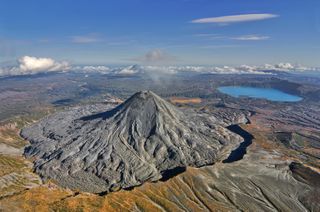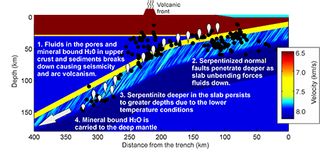
Earth's Conveyor Belts Trap Oceans of Water

Water, water, everywhere, even deep inside the Earth. That's the outcome of collisions between the planet's grinding tectonic plates, according to a new study.
At subduction zones, where one plate bends deep beneath another, the sinking plate acts like a conveyor belt, carrying more than an ocean's worth of water into the mantle — the layer beneath Earth's outer crust — over billions of years, researchers report in the Jan. 10 issue of the journal Geology. Though the lifetime of a single subduction zone is much shorter than a billion years, the cumulative effect of all of Earth's subduction zones trundling water downward into the mantle means more water could be stored in the planet's deep layers than previously thought, the study researchers said in a statement.
"This supports the theory that there are large amounts of water stored deep in the Earth," Tom Garth, lead study author and an earthquake seismologist at the University of Liverpool in the U.K., said in the statement.
Water in the mantle isn't in pools or lakes, but rather tiny droplets caught in microscopic spaces between the mantle's crystals . Earlier studies have hinted that huge amounts of water may be stored in the mantle, but the total amount is fiercely debated.
Knowing how much water gets into the mantle is important for modeling how plate tectonics works and how magma (molten rock) rises from the mantle to Earth's surface, the researchers said in a statement. For example, similar to how adding a little water makes it easier to stir a thick cake mix, water can make rocks less sticky, or viscous, and therefore flow more easily. [Infographic: What is Earth Made Of?]
Earthquakes reveal clues
Garth and his co-authors calculated how much water a subduction zone transports by analyzing earthquakes underneath northern Japan. Here, the Pacific Plate dives beneath Japan. Earthquakes in the descending slab —geology jargon for the Pacific Plate's sinking oceanic crust — are slower than expected because of the presence of lots of water-altered minerals, according to computer modeling by the research team.
Sign up for the Live Science daily newsletter now
Get the world’s most fascinating discoveries delivered straight to your inbox.

Scientists have long known that some of the water in a sinking slab escapes the crust and travels upward, altering the rocks above a subduction zone. These escaping fluids also trigger melting, and are the source of the spectacular volcanic chains that appear above subduction zones, such as in the Andes, the Aleutian Islands and Indonesia.
But the seismic evidence from Japan suggests faults within the Pacific Plate also trap water in a mineral called serpentine, Garth and his colleagues report. (The Pacific Plate, and all sinking subduction zone plates, have smaller faults within them from the stress of bending downward.)
A "wet" mineral, serpentine fills the faults, as much as 50 percent to 71 percent, according to the seismic evidence. (Differences in speeds at which seismic waves travel through the ground can be used to gauge what minerals occur at a certain depth.) This translates into the oceanic crust sucking down 170 to 318 teragrams (170 to 318 million metric tons) of water every million years into the mantle. (The mass of the oceans is about a billion times larger than this.)
"We found that fault zones that form in the deep oceanic trench offshore Northern Japan persist to depths of up to 150 kilometers [90 miles]," Garth said. "These hydrated fault zones can carry large amounts of water, suggesting that subduction zones carry much more water from the ocean down to the mantle than has previously been suggested."
Email Becky Oskin or follow her @beckyoskin. Follow OurAmazingPlanet @OAPlanet, Facebook and Google+. Original article at LiveScience's OurAmazingPlanet.
